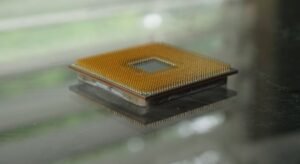Who Made AI First
Artificial Intelligence (AI) has become an integral part of our modern technological world. From voice assistants to self-driving cars, AI has revolutionized various industries. But who was the pioneer behind the creation of AI? In this article, we will explore the origins of AI and the minds that contributed to its development.
Key Takeaways:
- Alan Turing’s concept of a “universal machine” laid the foundation for AI research.
- John McCarthy coined the term “Artificial Intelligence” and organized the Dartmouth Conference.
- The development of expert systems in the 1970s and 1980s brought AI into practical applications.
- Deep learning has significantly advanced AI capabilities in recent years.
*While the concept of AI can be traced back to ancient times, the birth of modern AI can be attributed to the groundbreaking work of Alan Turing during World War II. Turing’s idea of a “universal machine” that could simulate any other machine laid the foundation for the development of AI as we know it today.*
It was in the 1950s and 1960s that AI research gained significant momentum. In 1950, Alan Turing introduced the “Turing Test,” a measure of a machine’s ability to exhibit intelligent behavior indistinguishable from that of a human. Around the same time, John McCarthy, often referred to as the father of AI, coined the term “Artificial Intelligence” and organized the Dartmouth Conference in 1956, which is considered the birthplace of AI research.
| Year | Event |
|---|---|
| 1943 | McCulloch and Pitts develop the first artificial neuron. |
| 1950 | Alan Turing introduces the “Turing Test.” |
| 1956 | John McCarthy organizes the Dartmouth Conference. |
During the 1970s and 1980s, AI research shifted towards the development of expert systems. Expert systems aimed to mimic the decision-making abilities of human experts in specialized domains. Limited by the knowledge available at the time, these systems paved the way for practical AI applications, such as medical diagnostics and financial planning.
- The development of expert systems in the 1970s and 1980s brought AI into practical applications.
- Expert systems aimed to mimic the decision-making abilities of human experts in specialized domains.
*One of the significant breakthroughs in AI research came in the form of deep learning. Deep learning is a subfield of AI that focuses on training artificial neural networks with multiple layers to recognize patterns and make complex decisions. This approach has revolutionized image and speech recognition, natural language processing, and even autonomous vehicles.*
| Year | Development |
|---|---|
| 1997 | IBM’s Deep Blue defeats world chess champion Garry Kasparov. |
| 2011 | IBM’s Watson wins against human contestants on Jeopardy! |
| 2016 | AlphaGo defeats world champion Go player Lee Sedol. |
In recent years, investments in AI research and the availability of vast datasets have propelled the field forward. Companies like Google, Facebook, and Amazon have made significant strides in the development of AI technologies, such as self-driving cars and virtual assistants, further blurring the line between science fiction and reality.
Final Thoughts
*From Alan Turing’s conceptualization of a universal machine to the rise of deep learning, AI has significantly evolved over time. While it is impossible to pinpoint a single person or event as the sole creator of AI, it is the collective efforts and contributions of countless researchers and innovators that have propelled this field to unprecedented heights. AI continues to advance, promising a future filled with endless possibilities.*

Common Misconceptions
1. AI was created by a single individual
One common misconception about AI is that it was created by a single person. In reality, AI development has been a collaborative effort by many researchers and scientists over several decades.
- The development of AI involved contributions from multiple researchers and organizations.
- AI development has been a result of trial and error, with many iterations and improvements along the way.
- Advancements in AI are a collective effort, with different individuals contributing to different aspects of the technology.
2. AI is purely a human creation
Another prevalent misconception is that AI is solely a human creation. While humans have been instrumental in developing AI technologies, nature has also played a role in inspiring and influencing AI algorithms and designs.
- Nature-inspired algorithms, such as genetic algorithms and neural networks, have been used extensively in AI development.
- Mimicking natural intelligence and behaviors has been a key strategy in AI research.
- Observing natural systems has provided insights into solving complex problems using AI techniques.
3. AI is always intelligent and self-aware
Contrary to popular belief, AI is not always intelligent or self-aware. While AI systems can perform specific tasks with remarkable efficiency, they lack true general intelligence and self-awareness seen in human beings.
- AI systems are designed to perform specific tasks and are limited to those domains.
- AI lacks the ability to understand context, emotions, and abstract concepts like humans do.
- AI algorithms rely on patterns and data rather than conscious understanding.
4. AI will replace human jobs entirely
A common fear surrounding AI is that it will replace human jobs entirely, rendering human workers obsolete. However, while AI has the potential to automate certain tasks, it is unlikely to completely eliminate the need for human workers.
- AI is more effective at automating repetitive and routine tasks, but it struggles with complex and creative tasks that require human insight.
- AI can complement human workers, allowing them to focus on higher-value tasks while automating tedious ones.
- New job opportunities will emerge as AI technology advances, creating new roles that require human skills and expertise.
5. AI is infallible and bias-free
Finally, there is a misconception that AI systems are infallible and completely bias-free. However, AI systems can inherit and even amplify biases present in the data and algorithms used to train them.
- AI systems learn from historical data, which may contain biases present in society.
- Without careful consideration, AI systems can perpetuate and amplify existing biases, leading to unfair or discriminatory outcomes.
- Ethical considerations and ongoing monitoring are necessary to ensure AI systems are fair and unbiased.

The Evolution of AI: Milestones and Pioneers
Artificial intelligence (AI) has come a long way since its inception, with countless groundbreaking achievements along the path of its development. This article explores the key milestones and notable pioneers that have contributed to the advancement of AI.
The Game Changer: Deep Blue vs. Garry Kasparov
In 1997, IBM’s deep blue supercomputer faced off against world chess champion Garry Kasparov, making it the first computer to defeat a reigning world champion in a standard chess game.
Breaking Barriers: AlphaGo vs. Lee Sedol
In 2016, DeepMind’s AI program, AlphaGo, made history by defeating the world champion Go player, Lee Sedol, in a five-game match. This victory showcased AI’s ability to tackle complex problems beyond traditional games.
Virtual Assistants: Introduction of Siri
Apple introduced Siri, the voice-activated virtual assistant, in 2011. This significant development brought AI technology into the mainstream and changed the way users interacted with their smartphones.
Face Recognition Advancements: DeepFace by Facebook
Facebook’s DeepFace algorithm, unveiled in 2014, demonstrated impressive accuracy in facial recognition tasks by achieving near-human performance, marking a substantial breakthrough in computer vision and AI.
Self-Driving Revolution: Tesla Autopilot
Tesla made waves in 2014 with the introduction of their Autopilot feature, allowing their vehicles to autonomously navigate and follow traffic. This technology revolutionized the automotive industry and paved the way for further autonomous vehicles.
Language Mastery: Google Translate
Google Translate, launched in 2006, utilizes AI and machine learning to provide instant translations between numerous languages. This tool has made cross-cultural communication easier and more accessible than ever before.
Empowering Visual Creativity: Deep Dream
Deep Dream, a neural network created by Google, generates surreal and visually captivating images by analyzing and modifying existing pictures. This project showcased AI’s potential for creative expression.
Healthcare Innovations: IBM Watson
IBM Watson, an AI system, showcased its capabilities by diagnosing a rare form of leukemia that stumped doctors. This breakthrough highlighted AI’s potential to support medical professionals in diagnosing and treating diseases.
Personalized Recommendations: Netflix’s Algorithm
Netflix’s algorithm, powered by AI, analyzes user preferences to provide personalized recommendations. This innovation has transformed the way we discover and enjoy movies and shows.
In conclusion, AI has made significant strides since its inception, revolutionizing industries and transforming the way we interact with technology. From defeating chess champions to enabling autonomous vehicles, AI’s impact continues to grow, promising a future of endless possibilities.
Frequently Asked Questions
Who is credited with creating the first artificial intelligence?
The creation of artificial intelligence can be attributed to multiple individuals. While the concept of AI traces back to ancient times, the modern foundations were laid by John McCarthy, Marvin Minsky, Nathaniel Rochester, and Claude Shannon at the Dartmouth Conference in 1956.
What is the Dartmouth Conference?
The Dartmouth Conference was a pivotal event held in 1956 at Dartmouth College in New Hampshire, USA. It is widely recognized as the birthplace of artificial intelligence as it brought together leading experts who explored the possibility of creating intelligent machines.
What were some early milestones in AI development?
Several significant milestones shaped the development of AI. In 1952, Arthur Samuel created the first self-learning program. In 1956, the Dartmouth Conference marked the formal birth of AI. The 1960s saw the development of rule-based systems, and in the 1970s, expert systems gained prominence.
When was the term “artificial intelligence” coined?
The term “artificial intelligence” was coined by John McCarthy, one of the pioneers of AI, at the Dartmouth Conference in 1956. McCarthy defined AI as the science and engineering of making intelligent machines capable of performing tasks that would otherwise require human intelligence.
Who contributed to the development of AI?
Several individuals made significant contributions to the development of AI. Some notable figures include John McCarthy, Marvin Minsky, Alan Turing, Arthur Samuel, Herbert Simon, and Allen Newell, to name a few. Each played a crucial role in advancing various aspects of AI research.
What is the difference between narrow AI and general AI?
Narrow AI, also known as weak AI, refers to AI systems designed to perform specific tasks or solve specific problems, such as voice recognition or playing chess. On the other hand, general AI, also called strong AI, aims to develop machines that possess human-like intelligence and can handle any intellectual task.
How has AI evolved over time?
AI has evolved significantly over time. Initially, AI focused on rule-based systems and expert systems. Then, machine learning techniques emerged, allowing computers to learn from data and improve performance. Recent advancements include deep learning, neural networks, and natural language processing, which have propelled AI to new frontiers.
What are some applications of AI today?
AI is being extensively used across various industries and domains. Common applications include virtual personal assistants (e.g., Siri, Alexa), recommendation systems, autonomous vehicles, fraud detection, healthcare diagnostics, and financial forecasting. Its potential is vast and continues to expand.
What are the ethical concerns surrounding AI?
Ethical concerns surrounding AI revolve around issues such as job displacement, privacy and data security, biased decision-making, transparency, and AI’s potential to be weaponized or used for malicious purposes. These concerns highlight the need for responsible development and deployment of AI systems.
What does the future of AI look like?
The future of AI holds great potential. Advancements in AI are expected to revolutionize industries, improve efficiency, and enhance the overall quality of life. However, the path forward also necessitates careful consideration of ethical, legal, and social implications to ensure AI benefits humanity.





